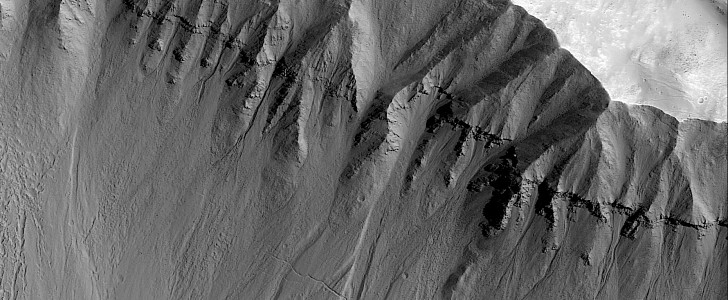Once we really get the exploration of Mars going (and by that, I mostly mean sending people over there for a first hand look), we’ll probably discover a whole lot of interesting, weird, or possibly even frightening things. But if there’s one thing we’re sure about, it’s this: we will not find any monsters there.
Yet, for one reason or another, a great deal of the photos sent back by the HiRISE camera spinning in orbit around the planet are constantly filled with dreadful creatures. At least, that’s how our minds sometimes interpret what the eyes are seeing, as they are trying to make some sense of that truly alien place.
Take the main photo of this piece as a reference. It kind of looks like it shows a closeup of some Martian monster’s crooked teeth, as seen through some X-ray machine before a dentist appointment. Only it’s not, of course.
What we’re seeing here are actually gullies, features that usually form on account of erosion by means of running water, or mass movement. Mars is filled with such formations, and the ones we have here are located in the walls of an impact crater in the Tempe Terra region of the planet.
What’s interesting about these gullies is their age. Now, lacking access to samples from the area, NASA does not know exactly how old they are, but they at least look “quite older than other gullies imaged by HiRISE elsewhere on Mars.”
Among other things, scientists are certain of that reality on account of the gullies’ gentle, smooth-looking slopes, which are the exact opposite of what younger such features have.
This particular image was captured by HiRISE from an altitude of 298 km (185 miles), and should eventually help us humans “estimate the relative age of terrains on Mars and other planetary surfaces."
Take the main photo of this piece as a reference. It kind of looks like it shows a closeup of some Martian monster’s crooked teeth, as seen through some X-ray machine before a dentist appointment. Only it’s not, of course.
What we’re seeing here are actually gullies, features that usually form on account of erosion by means of running water, or mass movement. Mars is filled with such formations, and the ones we have here are located in the walls of an impact crater in the Tempe Terra region of the planet.
What’s interesting about these gullies is their age. Now, lacking access to samples from the area, NASA does not know exactly how old they are, but they at least look “quite older than other gullies imaged by HiRISE elsewhere on Mars.”
Among other things, scientists are certain of that reality on account of the gullies’ gentle, smooth-looking slopes, which are the exact opposite of what younger such features have.
This particular image was captured by HiRISE from an altitude of 298 km (185 miles), and should eventually help us humans “estimate the relative age of terrains on Mars and other planetary surfaces."






